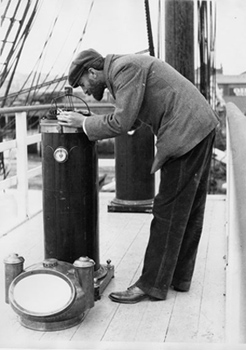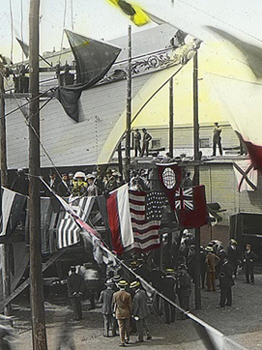Following its founding, the Department immediately set to work. The task at hand was clear, but enormous. The United States and much of Western Europe could be counted upon to survey and report on their own lands. However, little was known about the magnetic field of the rest of the earth, especially the oceans. The overall scope of the Department's efforts included expeditions to territories without the means to conduct their own surveys; permanent observatories in Watheroo, Australia, and Huancayo, Peru, to measure local, or secular, variation over time; and ocean expeditions covering the globe.
 |
| L.A. Bauer on the bridge of the Galilee using a "sea deflector" |
Bauer wasted no time, and in 1905 commissioned and fitted the brigantine Galilee for the Department's first ocean expedition. Bauer's mission with the Galilee was to collect data on the variations in the earth's magnetic field throughout the Pacific Ocean. After three voyages, it was clear that better results could be obtained by a vessel constructed of non-magnetic materials, and in 1909 the specially-built Carnegie was launched. Over twenty years the Carnegie made seven voyages covering 342,681 miles, studying the earth's magnetic field as well as other oceanographic and meteorological research.
The expeditions took the sailors and DTM observers to remote parts of the globe, sometimes putting them in contact with cultures virtually untouched by the western world. One of the Carnegie's most impressive cruises was a complete circumnavigation of Antarctica in a single season, ending in Buenos Aries, Argentina during World War I. The yacht was forced to stay in port while a German ship patrolled the area sinking allied vessels. Following the sixth cruise in 1921 the Carnegie was decommissioned for several years when the Carnegie Institution came under the leadership of Dr. John C. Merriam, who did not think it necessary to continue ocean expeditions. However, in 1927 the Carnegie was recommissioned to compete in the growing international field of oceanography. In 1929, during her seventh cruise, the Carnegie exploded while refueling in Apia, Samoa, and sank. Two lives were lost in the tragedy – the cabin boy and the captain, J. P. Ault. The Department did not endeavor to replace the vessel, thus marking the end of its ocean survey expeditions. .
 |
| The christening of the Carnegie in Brooklyn, 1909 |
The work of the Department of Terrestrial Magnetism stayed at least partially true to its name until the 1940s. It continued the land expeditions into the 1930s, and continued to operate the permanent observatories in Australia and Peru until 1947 when they were turned over to the local governments. The Department also remained active in collaborations with other organizations engaged in magnetic survey work, and the expeditions for which they supplied instruments and observers included several arctic and Antarctic expeditions.
Following Bauer's death, his second-in-command, John A. Fleming became first Acting Director in 1930, then Director in 1935. He stayed true to Bauer's vision while also expanding the Department's scope beyond geomagnetism. When Fleming retired in 1946, his successor Merle A. Tuve brought DTM's magnetic survey era to a close and charted a new course for the Department in seismology, geochemistry, and astronomy. In two hefty volumes published the following year – The Geomagnetic Field, its Description and Analysis and Description of the Earth's Main Magnetic Field and its Secular Change – DTM scientists synthesized all that had been learned in the four decades of the World Magnetic Survey.
